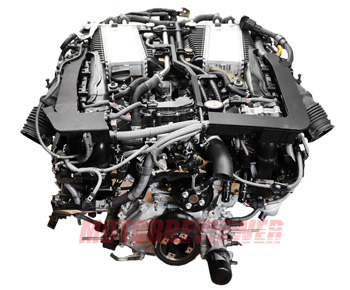Toyota V35A-FTS 3.5L Twin Turbo Engine Specs, Problems & Reliability

The V35A-FTS is a 3.5-liter twin-turbocharged V6 gasoline engine that debuted in 2017 with the fifth-generation Lexus LS 500. This new member of Toyota's Dynamic Force engine family is the first turbocharged V-engine in Toyota's history. The manufacturer has already stopped using all V8 engines (1UR-FE, 3UR-FE) in Toyota and Lexus vehicles and switched to this 3.5-liter twin-turbo V6. For example, the V35A-FTS became the only option for such popular models as the Toyota Land Cruiser, Toyota Tundra, Lexus LX 600, Lexus GX 550, etc. The new engine is not only full of technical solutions similar to the already well-known inline-4 A25A and M20A engines but also makes several steps forward. The engine achieves 37% thermal efficiency.
Toyota V35A-FTS Engine Overview
The engine has an aluminum open-deck style engine block with thin cast iron liners fused into the block material. The rough outer surface of liners promotes a strong connection and good heat transfer. The aluminum alloy bedplate mounted to the block provides increased rigidity to the structure. The oil pan has a two-piece design: the upper part is cast aluminum, and the lower part is a steel-stamped cover with a drain plug. The bottom includes a lightweight crankshaft with five balance weights and four narrow journals, lightweight aluminum pistons with friction-reducing polymer coating, compression and oil rings with anti-wear PVD coating, and fully floating piston pins. Each cylinder of the V35A engine is equipped with an oil spray squirter with two oil nozzles to spray oil onto the bottom of the piston and reduce its temperature.
On top of each cylinder bank, there is an aluminum alloy cylinder head with four valves per cylinder and a separate housing mounted on top for two camshafts. The head design utilizes laser-sprayed intake valve seats instead of traditional press-fitted ones. Intake channels are almost straight, and the exhaust manifold is integrated into the cylinder head. Like other modern engines, the integrated exhaust manifold is also water-cooled to help shorten engine warm-up times and reduce emissions. For each cylinder, there are two intake and two exhaust valves (sodium-cooled). The angle between the intake and exhaust valves is 41 degrees. The valve springs have a conical shape in the upper part, allowing the use of small and light spring retainers. The valves themselves are actuated by a camshaft via roller rocker arms, and the valvetrain has hydraulic valve lash adjusters. There are three timing chains in this engine. The intake camshafts are driven by the primary roller timing chain. Inside each cylinder head, there is a short secondary chain to drive the exhaust camshaft. The V35A features dual variable valve timing (DVVT). The intake side is equipped with an electric motor-operated variable valve timing (VVT-iE), and the exhaust camshafts use conventional hydraulic VVT-i. The exhaust camshaft on the right side (passenger side) of the engine also drives a vacuum pump. On top of each head, there is a polymer cylinder head cover, which has an oil delivery channel inside.
The 3.4L V35A engine is equipped with a combined fuel injection system (D-4ST), which means that it has direct injection nozzles that feed fuel directly into the combustion chambers and a traditional multi-point fuel injection system that sprays fuel into the intake ports in front of the intake valves. Each cylinder head has its own high-pressure fuel pump, driven by an additional lobe on each exhaust camshaft. Depending on engine needs, those pumps provide fuel pressure in the range of 2.4-20 MPa inside the forged steel high-pressure fuel rails used for the direct injectors. The conventional fuel pump (low pressure) feeds high-pressure pumps and the low-pressure fuel rail of the multi-point injection system. While direct injectors come with 6-point nozzles, low-pressure injectors have nozzles with 10 holes.
The engine is equipped with two parallel turbochargers (one on each side) with electronically controlled wastegate valves. Each turbocharger sends compressed air through its own air-to-water intercooler integrated inside a polymer intake air surge tank mounted on top of the engine. Intercoolers and turbochargers use a separate cooling system with an additional radiator and electric pump. Underneath the air surge tank, there is a two-piece aluminum, lightweight, and thin intake manifold. The exhaust system is equipped with two catalytic converters and, in addition, two Toyota's gasoline particulate filters (GPF).
Engine Specs
7.1 (7.5 qt) – AWD models
The V35A-FTS Engine Problems and Reliability
It is difficult to say at this point how reliable this engine is because it has not yet become widespread; in fact, it is currently available only for the premium Lexus LS 500 model. But like 2.7L EcoBoost and 3.5L EcoBoost engines in Ford's model range, very soon, the 3.5-liter V35A-FTS twin-turbo engine will take a place under the hood in numerous Toyota models such as Toyota Land Cruiser, Toyota Tacoma, Toyota Tundra, etc. And then only time will tell how reliable this technically sophisticated engine is in the long run.
